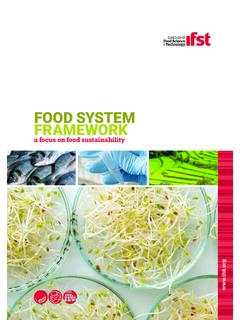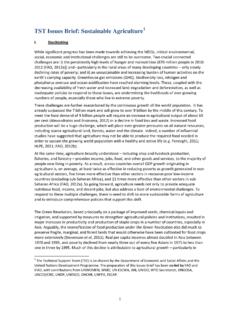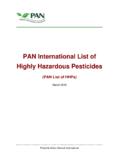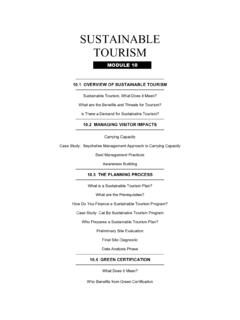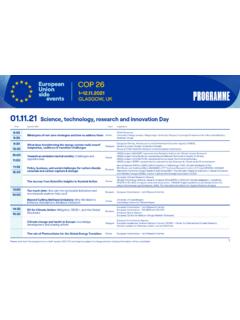Transcription of FOOD WASTE INDEX REPORT 2021 - 一般社団法人日本 ...
1 food WASTE INDEX REPORT 2021 food WASTE INDEX REPORT 2021 2021 united nations environment ProgrammeISBN No: 978-92-807-3851-3 Job No: DTI/2349/PAThis publication may be reproduced in whole or in part and in any form for educational or non-profit services without special permission from the copyright holder, provided acknowledgement of the source is made. united nations environment programme would appreciate receiving a copy of any publication that uses this publication as a use of this publication may be made for resale or any other commercial purpose whatsoever without prior permission in writing from the united nations environment programme .
2 Applications for such permission, with a statement of the purpose and extent of the reproduction, should be addressed to the Director, Communication Division, united nations environment programme , P. O. Box 30552, Nairobi 00100, designations employed and the presentation of the material in this publication do not imply the expression of any opinion whatsoever on the part of the Secretariat of the united nations concerning the legal status of any country, territory or city or area or of its authorities, or concerning the delimitation of its frontiers or illustrations or graphics appearing in this publication may have been adapted from content published by third parties.
3 This may have been done to illustrate and communicate the authors own interpretations of the key messages emerging from illustrations or graphics produced by third parties. In such cases, material in this publication do not imply the expression of any opinion whatsoever on the part of united nations environment programme concerning the source materials used as a basis for such graphics or of a commercial company or product in this document does not imply endorsement by the united nations environment programme or the use of information from this document for publicity or advertising is not permitted. Trademark names and symbols are used in an editorial fashion with no intention on infringement of trademark or copyright views expressed in this publication are those of the authors and do not necessarily reflect the views of the united nations environment regret any errors or omissions that may have been unwittingly citationUnited nations environment programme (2021).
4 food WASTE INDEX REPORT 2021. food WASTE INDEX REPORT 2021 ACKNOWLEDGEMENTSA uthors: Hamish Forbes (WRAP), Tom Quested (WRAP), Clementine O Connor ( united nations environment programme )Peer reviewers (modelling): Carola Fabi & Sharon Mayienga (FAO), Gang Liu (University of Southern Denmark), Julian Parfitt (Anthesis Group), Gustavo Porpino (Embrapa), Felicitas Schneider (Th nen-Institut).Other contributors and reviewers: Martina Otto (UNEP), Dany Ghafari (UNEP), Ludgarde Coppens (UNEP), James Lomax (UNEP), Jean-Pierre Sfeir (UNEP), Richard Swannell (WRAP), Billy Harris (WRAP), Sam Gillick-Daniels (WRAP), Andrew Parry (WRAP).
5 3 ACKNOWLEDGEMENTSFOREWORD: UNEP food WASTE INDEX REPORT If food loss and WASTE were a country, it would be the third biggest source of greenhouse gas emissions. food WASTE also burdens WASTE management systems, exacerbates food insecurity, making it a major contributor to the three planetary crises of climate change, nature and biodiversity loss, and pollution and WASTE . This is why sustainable Development Goal aims to halve food WASTE and reduce food loss by 2030. In support of this vital target, UNEP s first food WASTE INDEX REPORT provides insights into the scale of food WASTE and a methodology that enables countries to measure baselines and track progress in meeting the SDG target.
6 The REPORT estimates that food WASTE from households, retail establishments and the food service industry totals 931 million tonnes each year. Nearly 570 million tonnes of this WASTE occurs at the household level. The REPORT also reveals that the global average of 74 kg per capita of food wasted each year is remarkably similar from lower-middle income to high-income countries, suggesting that most countries have room to is fitting that this REPORT is being launched just after the fifth united nations environment Assembly, which at its previous meeting urged Member States to establish mechanisms for measuring food loss and WASTE , and requested support in providing technical assistance that would allow countries to make measure and make progress.
7 The REPORT is a first step in meeting this request. In April, we will establish regional food WASTE working groups in Africa, Asia Pacific, Latin America and the Caribbean, and West Asia to support member states in developing food baseline baselines and strategies bringing the REPORT to life. The REPORT is also part of UNEP s offer to the UN food Systems Summit process, with the aim of encouraging the widespread adoption of a Target-Measure-Act approach to food WASTE countries and private sector actors have already taken the commitment to heart. There is growing evidence of success in reducing food WASTE though not at the scale needed to achieve the target.
8 Much more can be done. We need, for example, to address the role of consumer behaviour, in all cultural contexts, in achieving the target. Let us all shop carefully, cook creatively and make wasting food anywhere socially unacceptable while we strive to provide healthy, sustainable diets to AndersenExecutive Director united nations environment programme , March 20214 UNEP food WASTE INDEX REPORT 2021 TABLE OF CONTENTS ACKNOWLEDGEMENTS ..3 LIST OF TABLES ..6 LIST OF FIGURES ..6 LIST OF BOXES ..6 EXECUTIVE SUMMARY ..7 KEY FINDINGS ..81 INTRODUCTION .. THE food WASTE INDEX AND sustainable DEVELOPMENT GOAL.
9 212 INDEX LEVEL 1: EXISTING DATA AND EXT RAPOLAT ION TO OTHER COUNTRIES .. LEVEL 1 ESTIMATES OF food WASTE : WHAT AND WHY? .. SUMMARY OF THE METHODOLOGY .. RESULTS: DATA REGION-SPECIFIC DATA .. food WASTE AMOUNTS: MEASURED ESTIMATES AND EXTRAPOLATIONS ..543 INDEX LEVELS 2 AND 3: MEASURING food WASTE AT THE NATIONAL LEVEL .. OVERVIEW .. STEPS FOR MEASUREMENT .. DATA SOURCES, AVAILABILITY AND PRODUCTION .. SPECIFICS FOR LEVEL 3 .. METHODOLOGICAL CHALLENGES AND LIMITATIONS .. BENEFITS OF MEASUREMENT AND EXAMPLES ..904 DISCUSSION AND/OR RECOMMENDATIONS ..92 BIBLIOGRAPHY ..945 TABLE OF CONTENTSLIST OF TABLEST able 1: Average food WASTE (kg/capita/year) by World Bank income classification, averaging medium and high confidence estimates for 8 Table 2: Number of countries with measured data points, by sector and World Bank income classification.
10 11 Table 3: Countries with high confidence food WASTE estimates, by sector ..13 Table 4: Appropriate methods of measurement for different sectors ..15 Table 5: Coverage of relevant food WASTE data points globally, by sector ..27 Table 6: Number of countries with measured data points, by World Bank income classification . 27 Table 7: Number of countries with measured data points, by region (UNEP classification)..28 Table 8: Share of population residing in countries with existing estimates, by region ..29 Table 9: Share of global population residing in countries with existing estimates ..30 Table 10: Number of data points, by geographical scope 31 Table 11: Data points relating to households from African studies.
